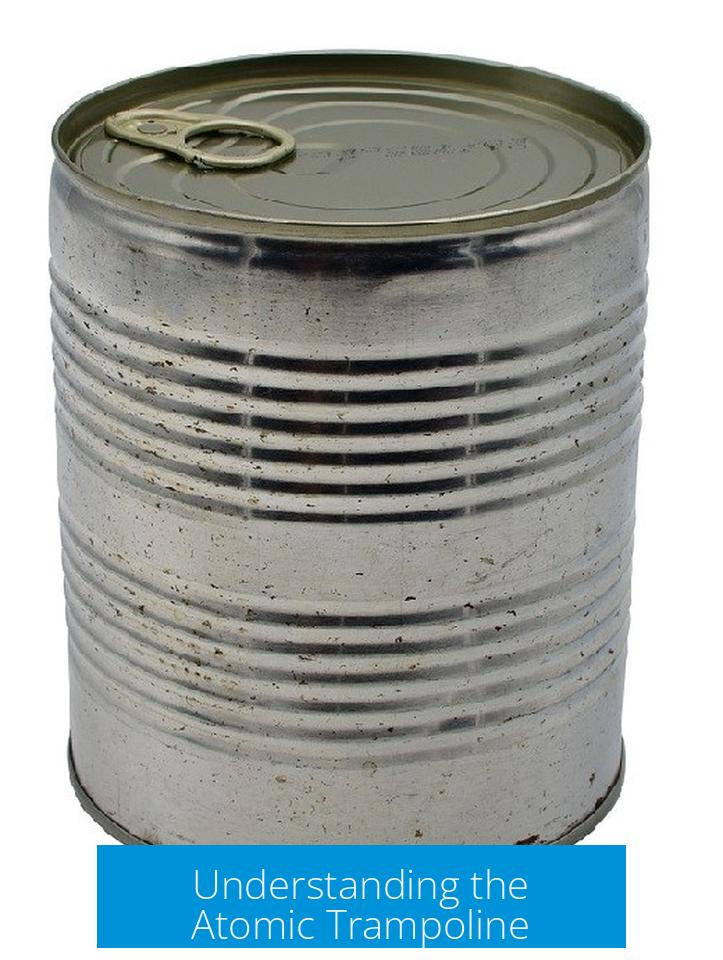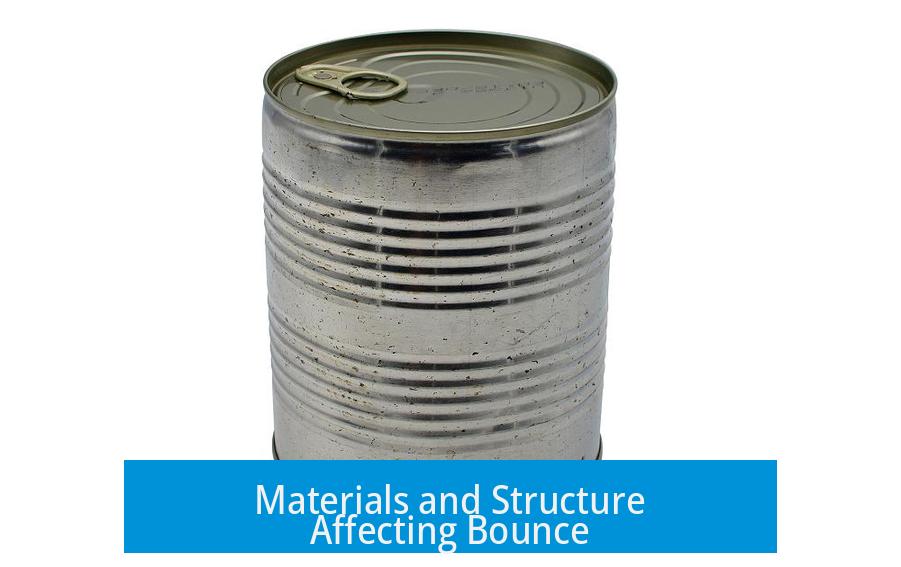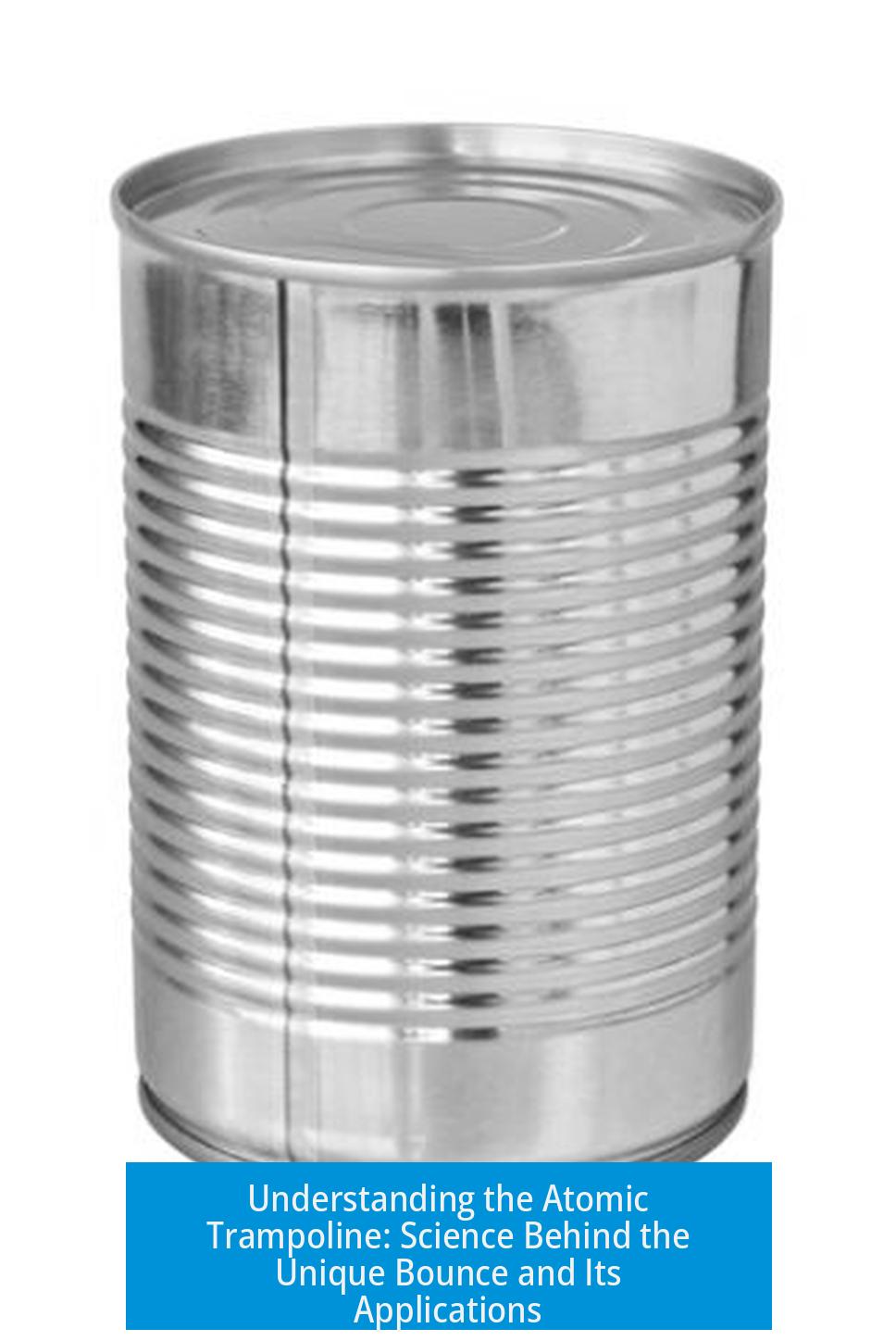Understanding the Atomic Trampoline

An atomic trampoline is a device that demonstrates the unusual bouncing behavior of a ball bearing on a special plate made from amorphous metal. This setup serves as a fascinating exploration into materials science, physics, and engineering principles.
What Makes the Atomic Trampoline Unique?

The core component is the trampoline plate crafted from amorphous metal. Unlike regular metals, this metal has a random atomic structure similar to that of a frozen liquid. This disordered atomic arrangement prevents the plate from deforming easily, even temporarily. When the ball bearing strikes the plate, its kinetic energy transfers to the metal atoms, causing subtle vibrational motion rather than visible deformation.
Materials and Structure Affecting Bounce

- The amorphous metal’s inability to deform elastically plays a key role in keeping more energy in the ball’s motion.
- Selection of ball bearing material and size affects the bounce by matching stiffness between the ball and plate.
- The underlying surface supporting the plate also influences the bounce duration by affecting energy dissipation.
Enhancing the Bounce: Experimental Insights

Experiments vary ball bearing materials, diameters, and plate support conditions to optimize bouncing performance. A crucial finding is that the best bounce occurs when stiffness of the ball bearing complements the plate’s stiffness. This match maximizes energy return to the ball.
Role of Environment: Vacuum Chamber Tests

Air resistance normally dissipates energy, reducing bounce time. Placing the atomic trampoline setup inside a vacuum chamber reduces this drag. Experiments show that in vacuum, the ball bearing can bounce for over a minute. This highlights air pressure as a major factor limiting bounce length.
Scientific Principles: Energy Transfer and Restitution

The phenomenon relies on the coefficient of restitution, which measures the efficiency of energy transfer during collisions. The unique atomic structure enables near-elastic collisions where most energy remains in the rebounding ball. This delicate balance between material stiffness and kinetic energy governs the mesmerizing bounce.
How to Perform the Atomic Trampoline Demonstration
- Place the stainless steel base with an amorphous metal disk appropriately fixed on a stable surface.
- Drop a ball bearing down a tube centered over the plate.
- Observe the ball’s prolonged bouncing, often far exceeding normal metal plate rebounds.
Key Takeaways
- The atomic trampoline uses an amorphous metal plate to create unusually long bounces.
- Random atomic structure prevents deformation, preserving kinetic energy in the ball.
- Matching stiffness of ball bearing and plate boosts bounce efficiency.
- Vacuum testing confirms reduced air resistance greatly extends bounce duration.
- Underlying physics involves energy transfer and coefficient of restitution principles.
Can Someone Explain This “Atomic Trampoline”? Let’s Bounce Into the Science!
The “atomic trampoline” isn’t a term you’ll find etched in scientific textbooks or whispered in physics lectures—it’s more of a catchy nickname for a fascinating phenomenon involving energy and materials on an atomic level. Imagine a ball bouncing seemingly forever on a special plate. Sounds like a magic trick, but it’s pure science, grounded in the funky behavior of a unique kind of metal. So, what’s really going on here? Buckle up, because we’ll unpack this curious bounce from the atomic jiggle to the material marvels behind it.
A Baffling Bounce: Not Your Average Trampoline
First, let’s clear something up: the atomic trampoline isn’t actually a trampoline made of atoms—that’d be pretty tiny and uncomfortable for jumping! Instead, it’s a metaphorical way to describe how certain materials behave like a trampoline at the atomic scale. They can absorb kinetic energy when something hits them and spring that energy right back, causing a ball bearing to bounce with surprising vigor and longevity.
This whole show revolves around a plate made from something called amorphous metal. Unlike your everyday metals, which have neat, tidy atomic structures arranged like a well-organized parking lot, amorphous metals are more like a chaotic, frozen liquid where atoms hang out randomly. This irregular layout means they handle energy differently.
Amorphous Metals: The Secret Sauce of Atomic Trampoline
Here’s where it gets interesting. Most metals are crystalline: their atoms stack side-by-side in repeating patterns. Such organized structures come with “defects”—grain boundaries, dislocations—that are basically tiny weak spots allowing the material to deform under force.
Amorphous metals toss that crystal order out the window. Imagine atoms of various sizes frozen into a messy jam without time to settle into a pattern. This lack of order means no conventional defects either. The entire structure acts more like a “sea of defects,” creating a very hard, stiff, and resilient material.
When a ball bearing hits this sturdy amorphous plate, the metal’s atoms can barely move. They jiggle but don’t slide or shift like atoms in crystalline metals do. That’s key: in typical metals, some energy “disappears” as atoms rearrange, causing the bounce to drop quicker. But here? Most kinetic energy doesn’t soak into the metal. Instead, it snaps right back into the ball bearing, giving that perfect trampoline bounce sensation, but at the atomic scale.
Energy Bounce: The Physics Behind the Trick
So, how exactly does this work? In physics lingo, we talk about the coefficient of restitution—a measure of how much energy returns to an object after it bounces. The closer this number is to 1, the more elastic the bounce.
Amorphous metals shine here. Because their chaotic atomic structure restricts atom movement, the kinetic energy transfers back almost fully. The ball bearing doesn’t just bounce—oh no—it practically defies expectations, much like a trampoline sending you sky-high at a party.
To put it visually, think of a game of atomic dodgeball. In crystalline metals, atoms dodge and weave, soaking up energy. In amorphous metals, the atoms are frozen in place with no room to dodge. So, the energy bounces off the ball instead.
Testing the Bounce: Experiments and Insights
This isn’t just theory. Practitioners have set up fascinating experiments that help us see this effect in action. Here’s a classic setup:
- A ball bearing drops onto a plate made of amorphous metal.
- Scientists vary the size and material of the ball bearing, always trying to balance stiffness with the plate.
- Adding a vacuum chamber removes air resistance, letting the bounce time leap past a full minute!
The last point is golden: air resistance normally steals energy from the bounce, but in a vacuum, the ball bearing keeps hopping almost indefinitely. So, it’s not just the atomic trampoline alone but the surrounding environment buffing up the show.
What’s in the Atomic Trampoline Setup?
For anyone wanting a peek under the hood, the atomic trampoline setup often includes:
- A stainless steel base plate coated with a thin disk of liquid metal (which is actually an amorphous metal).
- A precision ball bearing dropped down a tube, aimed to land perfectly in the center.
- A vacuum chamber surrounding the entire assembly to minimize energy loss from air.
When the ball bearing hits the surface, it bounces almost magically, demonstrating the near-perfect elastic energy return of the material.
Why Should You Care? The Practical Scoop
Why all this fuss about a bouncing ball and weird metals? Well, understanding the atomic trampoline effect unlocks new possibilities in materials engineering and physics.
For example, amorphous metals’ toughness and energy return can lead to highly durable and flexible components in technology. Think sports gear that absorbs shocks better, electronic components with better longevity, or industrial parts resisting wear and tear far longer.
Plus, this phenomenon teaches us about energy conservation at scales way smaller than we imagined. It’s a playful window into how atoms interact when pushed to their limits—a nifty blend of entertainment and education.
Putting It All Together: A Unique Perspective
The atomic trampoline is a fresh way to appreciate amorphous metals. Instead of dry explanations about atomic disorder or material science, the bouncing ball brings the concept alive. Watching kinetic energy bounce back from a tiny metallic landscape offers a tangible grasp of these complicated ideas.
And beyond the science, it sparks curiosity—prompting questions like: What other materials “trap” or “bounce back” energy so well? Could we develop new gadgets using these properties? How does this challenge what we thought about elasticity at an atomic scale?
This phenomenon blends clear science with a bit of wonder and play, proving even atoms have their own version of a trampoline party!
Final Thoughts
So, can someone explain the “atomic trampoline”? Absolutely. It’s a poetic nickname for the energy-bouncing behavior exhibited by amorphous metals—the hard, defect-free metal glasses that send kinetic energy right back instead of absorbing it. This effect leads to extraordinarily bouncy ball bearings, especially in controlled environments like vacuum chambers.
Beyond the bounce, the atomic trampoline invites us to rethink energy transfer, material structure, and the beauty hidden in the randomness of atoms. It’s a scientific curiosity with practical implications and a dash of fun. And if you ever get your hands on one of those setups, watching that ball bearing bounce is nothing short of mesmerizing—a delightful dance of atoms you won’t forget!
What makes the atomic trampoline’s bounce so unique?
The key is the amorphous metal plate. Its atoms are randomly arranged, unlike normal metals. This structure resists deformation, allowing the ball bearing to bounce unusually long by transferring energy efficiently.
How does the vacuum chamber affect the atomic trampoline bounce?
Removing air in the vacuum chamber reduces air resistance, which normally slows the bounce. In the vacuum, the ball bearing can bounce for over a minute, showing air resistance is a major factor in energy loss.
Why does matching stiffness of the ball bearing and plate matter?
Similar stiffness levels mean better energy transfer during impact. This alignment helps maximize the bounce by reducing energy lost through permanent deformation or internal friction.
What role does the coefficient of restitution play in the atomic trampoline?
It measures how much energy is preserved in impacts. High values mean less energy loss and longer bounces. The amorphous metal’s properties help achieve a high coefficient during collisions.
How is the atomic trampoline demonstration set up?
The setup includes a stainless steel base with a disk of liquid metal glued on top. Dropping a ball bearing onto this surface shows the unique bouncing behavior caused by the material properties of the plate.





Leave a Comment